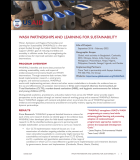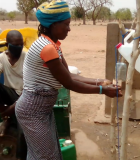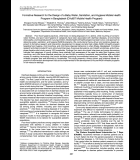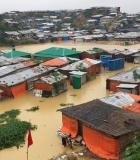Nobo Jibon (New Life)
Since June 2010, Save the Children has been implementing the USAID-supported Title II PL480 Multi-Year Assistance Program in Bangladesh, “Nobo Jibon.” The program is designed “to reduce food insecurity and vulnerability for 191,000 direct beneficiary households…in ten upazilas of Barisal Division over five years.” It has three strategic objectives (SOs) in the areas of maternal and child health and nutrition (SO1), market-based production and income generation (SO2), and disaster risk reduction (SO3), as well as a cross-cutting gender component.
Activity Description
The design of SO1 is based primarily on PM2A and adapted to the Bangladesh context. PM2A focuses on three core services: 1) conditional food ration; 2) preventative and curative nutrition services for women and children, according to national protocol; and 3) Behavior Change Communication (BCC). Consistent with PM2A, SO1 activities are directed primarily to PLW and women with U2 children. Nobo Jibon’s BCC approach uses best practices defined as Essential Nutrition Actions (ENA) – seven affordable and evidence-based nutrition interventions delivered at health facilities and communities to improve the nutritional status of women and children.
With the market-driven approach taken for the livelihood component, Nobo Jibon targets interventions for each part of the three-part market system: input markets; small businesses owned by Nobo Jibon beneficiaries; and output markets. The beneficiary small businesses are the main unit of implementation of the market-oriented program though which input and output market actors are also reached. Nobo Jibon developed three distinct implementation strategies: (1) homestead production for women; (2) value chain production for productive poor households; and (3) asset transfers for extreme poor households.
The primary aim of the DRR component is that households in targeted communities protect their lives and assets and quickly resume their livelihood activities following natural disasters. Interventions focus on the various factors that contribute to a household’s vulnerability and the ability to recover from disaster including emergency preparedness, physical infrastructure, agency coordination and early warning systems. SO3 activities directly or indirectly benefit all households (approximately 444,241) in the targeted project area. It is currently working in 1,143 communities. The particular package of interventions that any union receives is determined according to the relative disaster risk that the union is exposed to. Based on a vulnerability study carried out in in 86 unions in the 10 upazilas that the project works in, unions were classified into three categories according to disaster risk level. Only those unions (52) that were high risk or medium risk got DRR awareness training, household capacity building and food for work (FFW).
Expected Outcomes
• Improved health and nutritional status of children under the age of five (U5) and pregnant and lactating women (PLW)
• Poor and extremely poor households have increased production and income
• Households in targeted communities protect their lives and assets and quickly resume livelihood activities after disasters
Actual Outcomes
• Over the program period, moderate stunting decreased from 44 percent to 35 percent across all sample households – a 20 percent overall reduction
• Severe stunting rates, which ranged from a low of 10 percent in Barguna to a high of 18 percent in Barisal at baseline, also saw substantial improvement at endline, with a 22 percent reduction in the overall sample, and greater improvements in Barisal (29 percent reduction) and Barguna (28 percent reduction).
• Food hygiene behaviors increased more than 30 percent among all surveyed households
• The percentage of caregivers demonstrating proper water hygiene behaviors more than doubled overall from 44 percent to 91 percent of households





